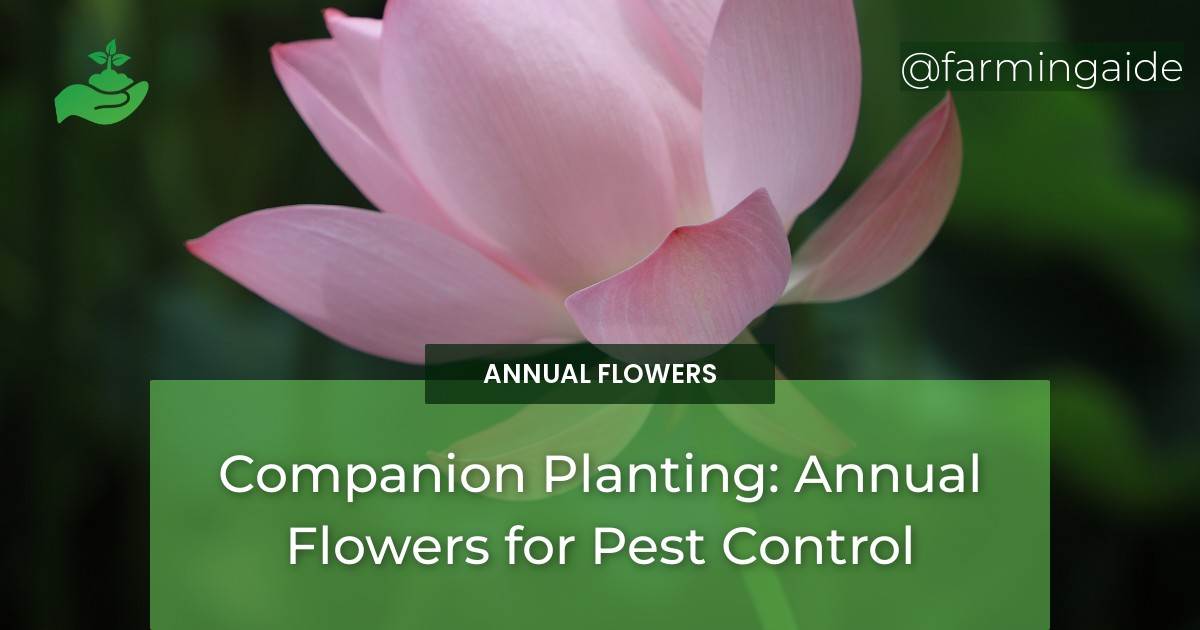Are you tired of pests ravaging your garden? Do you want a natural and effective way to control them? Companion planting might be the solution you are looking for! This age-old practice involves planting different species of plants together to enhance their growth and protect them from pests. In this article, we will explore the benefits of companion planting with annual flowers for pest control. We will discuss the advantages of using annual flowers, the different types of flowers that repel pests, and those that attract beneficial insects. We will also provide tips on how to companion plant with annual flowers, precautions to take, and common mistakes to avoid. Read on to find out how to create a beautiful and pest-free garden with the power of annual flowers and companion planting.
Benefits of Companion Planting with Annual Flowers
Companion planting with annual flowers provides multiple benefits beyond pest control. Firstly, it promotes biodiversity, which creates a healthier ecosystem for plants to thrive. Secondly, these flowers attract pollinators like bees and butterflies, which are crucial for fruit and seed production. Thirdly, some annual flowers can even improve soil quality by fixing nitrogen and other nutrients.
When it comes to pest control, annual flowers offer a natural and safe alternative to chemical pesticides. Chemicals can harm not only the pests but also the beneficial insects and organisms that keep the ecosystem in balance. On the other hand, companion planting with annual flowers repels pests without disrupting the natural balance. Furthermore, it reduces the risks of toxic residues on fruits and vegetables.
Annual Flowers that Repel Pests
Here are some examples of annual flowers that repel pests:
- Marigold: repels nematodes, whiteflies, and aphids with its strong scent.
- Nasturtium: repels aphids, whiteflies, and cabbage moths with its pungent odor.
- Petunia: repels leafhoppers, aphids, and tomato hornworms with its sticky hairs.
- Snapdragon: repels beetles, spider mites, and caterpillars with its bitter taste.
These annual flowers work by releasing chemicals or emitting odors that pests find unappealing. They can be planted among crops or in pots around the garden to act as a natural barrier against pests. However, keep in mind that not all pests are repelled by the same flowers, and some plants might attract more pests than they repel. Hence, it is crucial to choose the right combination of flowers for your specific pests and crops.
Annual Flowers that Attract Beneficial Insects
Beneficial insects are the natural enemies of pests, and they help to keep their populations in check. Here are some annual flowers that attract beneficial insects:
- Alyssum: attracts lacewings, hoverflies, and ladybugs, which feed on aphids, mites, and other pests.
- Bachelor’s button: attracts parasitoid wasps, which lay eggs inside caterpillars and other pests.
- Calendula: attracts hoverflies, which feed on aphids and thrips.
- Chrysanthemum: attracts predatory mites, which feed on spider mites and other small insects.
These flowers work by providing food and shelter for beneficial insects, which in turn decreases the pest population. They can be planted near crops or in borders around the garden to create a habitat for beneficial insects. However, keep in mind that some beneficial insects might also feed on crops or other flowers, so it is crucial to balance their presence accordingly.
How to Companion Plant with Annual Flowers
Companion planting with annual flowers requires careful planning and execution to maximize their benefits. Here are some tips on how to companion plant with annual flowers:
- Choose the right combination: select flowers that work well with your crops and pests. Research the specific properties of each flower and its compatibility with other plants.
- Plant in the right location: place flowers strategically around the garden to maximize their benefits. For example, plant pest-repelling flowers near susceptible crops, and beneficial-insect-attracting flowers near crops that need pollination.
- Plant at the right time: plant annual flowers at the same time as your crops or slightly before to establish a barrier against pests.
- Care for your flowers: maintain your flowers healthy and strong by watering, fertilizing, and pruning them regularly.
Precautions to Take When Companion Planting
Companion planting with annual flowers is generally safe and non-toxic, but some precautions must be taken to avoid problems. Here are some precautions to take:
- Avoid overcrowding: too many flowers can compete with each other for space, water, and nutrients.
- Rotate your crops: planting the same crops or flowers in the same place year after year can deplete the soil and promote pest infestations.
- Monitor your garden: observe your plants regularly for signs of pests or diseases and take action promptly.
Some common mistakes gardeners make when companion planting include planting incompatible plants, planting too late or too early, and neglecting their plants’ care. By following these precautions, you can avoid these mistakes and enjoy the benefits of companion planting with annual flowers.
Conclusion
Companion planting with annual flowers is a natural and effective way to control pests while promoting biodiversity and improving soil quality. By planting pest-repelling and beneficial-insect-attracting flowers strategically around your garden, you can create a beautiful and pest-free environment for your crops. Remember to choose the right combination of flowers, plant them in the right location and time, and care for them properly. With these tips and precautions, you can become a master of companion planting with annual flowers and enjoy a thriving garden all year round.


